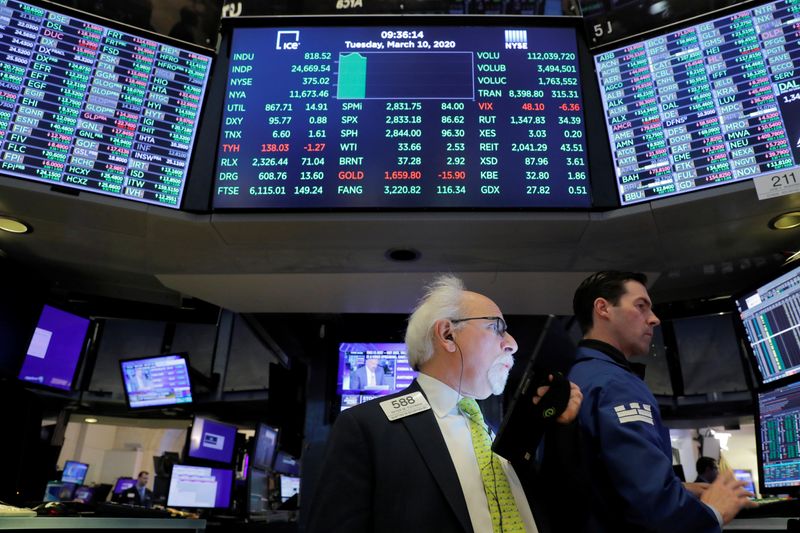Oil and global equity markets charged back on Tuesday after the prior day’s steep losses as the world’s biggest economies moved to cushion the impact of the coronavirus, but stock gains in Europe failed to hold as investors remained skittish.
The price of Brent crude climbed 10% on hopes a supply cut deal could be rescued and most benchmark government bond yields rose from record lows as governments outlined broad measures to confront the epidemic’s economic and human toll.
U.S. President Donald Trump said he will ask Congress for a payroll tax cut and other “very major” stimulus moves to ease the economic pain, but details were still forthcoming.
During a White House meeting with health executives, Trump also said the U.S. administration intended to help airlines and the cruise line industry. He later met with Republican senators to discuss proposals for boosting the economy.
Japan unveiled a second package of measures worth about $4 billion in spending, focusing on support to small and midsized firms.
U.S. stocks jumped more than 3% at the open, pared gains to trade briefly negative and then roared back to close up almost 5%. Investors hoped Monday’s rout marks the low of a downturn that has pushed Wall Street’s major indexes close to a bear market – defined as a decline of 20% from recent peaks.
“Investors are trying put a bottom in here,” said Rick Meckler, partner at Cherry Lane Investments in New Vernon, New Jersey.
“It seems like that yesterday was such a collection of so much bad news, it shocked the market down. Today with fresh eyes people are picking out the names they think have dropped the most,” Meckler said.
The S&P 500 forward price-earnings ratio for this year fell to 15.8 as of Monday, in line with the historic average and down from 19.3 less than a month ago, according to Refinitiv.
Comments by Vice President Mike Pence that private U.S. health insurance companies have agreed to cover coronavirus treatment and waive co-payment fees for testing helped U.S. stocks rebound.
On Wall Street, the Dow Jones Industrial Average rose 1,166.7 points, or 4.89%, to 25,017.72. The S&P 500 gained 135.65 points, or 4.94%, to 2,882.21 and the Nasdaq Composite added 393.58 points, or 4.95%, to 8,344.25.
MSCI’s gauge of stocks across the globe <.MIWD00000PUS> gained 2.55% but the pan-European STOXX 600 index lost 1.14%, after initially trading higher. A jump in infections in Italy, Germany and Britain unsettled investors.
The major European bourses remained in bear territory. The FTSE 100 in London almost eked out a gain but closed down 0.1% as oil companies rebounded from the carnage on Monday as Saudi Arabia and Russia engaged in a price war.
“Traders are a bit nervy, the only positive news we’ve been getting out is probably rate cuts or tax cuts,” said Michael Baker, an analyst at ETX Capital in London.
“We need news in terms of the actual control of the virus, which we don’t seem to be having right now,” he said.
Yields on benchmark U.S. 10-year Treasury debt more than doubled to 0.801% and those on German Bunds jumped around 20 basis points at one point as investors pared some safe-haven holdings, though they were beginning to ease again.
Many strategists and economists expect the Federal Reserve to cut U.S. interest rates to zero as part of a global move to provide strength and liquidity to the financial system.
The dollar rallied after huge losses against the safe-haven Japanese yen and Swiss franc, but analysts said it was too early to predict a floor.
Stocks in Asia rebounded, with Japan’s Nikkei <.N225> closing up 0.85% after touching its lowest level since April 2017. [.T]
China’s benchmark Shanghai Composite Index traded 1.8% higher as new domestic coronavirus cases tumbled and President Xi Jinping’s visit to the epicenter of the epidemic lifted sentiment.
The oil rally had the most horsepower. About half of oil’s massive losses from Monday were clawed back, offering hope that markets had found a floor despite still-fragile sentiment.
Russian oil minister Alexander Novak said he did not rule out joint measures with the Organization of the Petroleum Exporting Countries to stabilize the market.
Benchmark Brent crude futures rose 8.3% to settle at $37.22 a barrel, roughly half this year’s peak, reached in January. U.S. crude gained 10.4% to settle at $34.36. [O/R]
Gold prices fell 1%, retreating from the previous session’s jump above the key $1,700 level, as safe-haven demand waned a little amid speculation about global stimulus measures. [GOL/]
U.S. gold futures settled down 0.9% at $1,660.30 an ounce.
The bond market has priced in a global recession of unknown length. Investors are fully pricing an easing of at least 75 basis points at the next Fed meeting on March 18, while a cut to near zero was seen as likely by April. <0#FF:>
Yields on 10-year U.S. Treasuries dipped to as little as 0.318% on Monday – a level unthinkable just a week ago – but climbed back to 0.6787% on Tuesday amid the stimulus chatter.
(GRAPHIC: The U.S. dollar and 10-Year U.S real yields – https://fingfx.thomsonreuters.com/gfx/mkt/13/2942/2907/Pasted%20Image.jpg)
By Herbert Lash and Marc Jones



